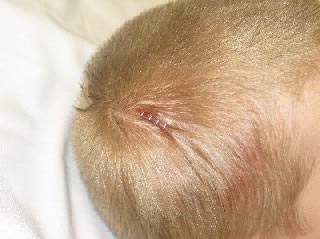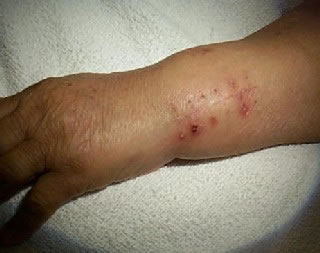Suture Questions
Is this your child's symptom?
- Sutures or stitches questions
- Stapled wounds are treated the same as sutured wounds
- Skin glue (Dermabond) questions are also covered
When Sutures (Stitches) are Needed for Cuts
- Any cut that is split open or gaping needs sutures.
- Cuts longer than ½ inch (12 mm) usually need sutures.
- On the face, cuts longer than ¼ inch (6 mm) usually need to be seen. They usually need closure with sutures or skin glue.
- Any open wound that may need sutures should be seen as soon as possible. Ideally, they should be checked and closed within 6 hours. Reason: to prevent wound infections. There is no cutoff, however, for treating open wounds.
When Sutures (Stitches) Should be Removed
- Stitches and staples are used to keep wounds together during healing.
- They need to be removed within 4-14 days.
- The specific removal date depends on the location of the stitches or staples.
- Removal should not be delayed. Reason: will leave skin marks.
Wounds That Re-Open After Closure
- Sutures that come out early cause the most concern.
- For open cuts, call your child's doctor now. General guidelines for re-suturing or re-gluing are listed below:
- Face Cuts. If a face wound has re-opened, call your doctor now. The cut may need to be re-glued or re-stitched. It does not matter how long it's been since sutures (or glue) were placed.
- Body Cuts and Less Than 48 Hours. If the wound is elsewhere on the body, call your doctor now. The cut may need restitched (or glued) if gaping open. This is sometimes done if suturing was less than 48 hours ago.
- Body Cuts and Over 48 Hours Ago. Call your doctor now for advice. After 48 hours, re-suturing is rarely done (except on the face). After 48 hours, the sutured wound can be reinforced with tape.
- Cut Is Closed, but suture has come out early. The wound should heal up fine without any further treatment. Check with your child's doctor within the next 24 hours.
See More Appropriate Topic (instead of this one):
- If NOT, try one of these: Wound Infection
- If NOT, try one of these: Skin Injury
When to Call Us for Suture Questions
Call 911 Now
- Not moving or too weak to stand
- You think your child has a life-threatening emergency
Call Doctor or Seek Care Now
- Stitch (or staple) came out early and wound has opened up
- Wound looks infected (spreading redness, pus)
- Fever occurs
- Your child looks or acts very sick
- You think your child needs to be seen, and the problem is urgent
Contact Doctor Within 24 Hours
- Suture came out early but wound is still closed
- Suture removal is overdue
- You think your child needs to be seen, but the problem is not urgent
Contact Doctor During Office Hours
- You have other questions or concerns
Self Care at Home
- Stitched or stapled wound with no other problems
Care Advice for Sutures
Care for a Normal Sutured or Stapled Wound:
- Keep sutured wounds completely dry for first 24 hours. (4 hours for Dermabond skin glue). If needed, use a sponge bath.
- After 24 hours, can take brief showers.
- Avoid swimming, baths or soaking the wound until sutures are removed. Avoid getting Dermabond skin glue wet until it has fallen off. Reason: water in the wound can interfere with healing.
- Use an antibiotic ointment (such as Polysporin) 3 times a day. No prescription is needed. Reason: to prevent infection and a thick scab. Caution: don't apply any ointments or creams to Dermabond skin glue.
- Cleanse surface with warm water once daily or if becomes dirty.
- Change wound dressing when wet or dirty.
- A dressing is no longer needed when edge of wound is closed. This takes about 48 hours. Exception: dressing is needed to prevent sutures from catching on clothing.
Pain Medicine:
- To help with the pain, give an acetaminophen product (such as Tylenol).
- Another choice is an ibuprofen product (such as Advil).
- Use as needed.
Suture (or Staple) Removal Date.
- Scalp: 7-10 days (same for staples)
- Face: 4-5 days
- Neck:?7 days
- Chest, abdomen or back: 7-10 days
- Arms and back of hands: 7 days
- Legs and top of feet: 10 days
- Palms, soles, fingers or toes: 12-14 days
- Overlying a joint: 12-14 days
Suture (or Staple) Removal Delays:
- Don't miss your appointment for removing sutures.
- Leaving sutures in too long can leave skin marks. Sometimes, it can cause scarring.
- It also makes taking the sutures out harder.
Suture (or Staple) Out Early:
- If the sutures come out early, close the wound with tape. You can also use a butterfly bandage.
- Do this until the office visit.
Wound Protection After Sutures (or Staples) Out:
- Protect the wound from injury during the month after.
- Avoid sports that could re-injure the wound. If a sport is essential, cover with tape before playing.
- Allow the scab to fall off on its own. Do not try to pick it off. Reason: prevents scarring.
Call Your Doctor If:
- Starts to looks infected
- Fever occurs
- Sutures come out early
- You think your child needs to be seen
- Your child becomes worse
Remember! Contact your doctor if you or your child develop any "Contact Your Doctor" symptoms.
Disclaimer: this health information is for educational purposes only. You, the reader, assume full responsibility for how you choose to use it.

Laceration - Scalp (After Staples)
This photo shows a scalp laceration after it has been closed with 4 metal medical staples.

Wound Infection - Suture Site
There is a pimple where a stitch comes through the skin. The pimple suggests a low-grade infection.
Copyright 2000-2025 Schmitt Pediatric Guidelines LLC.